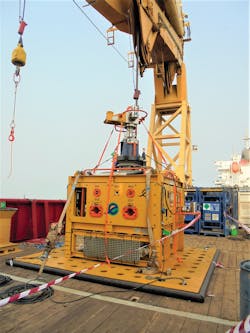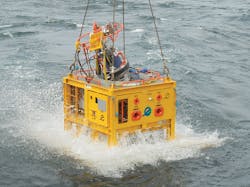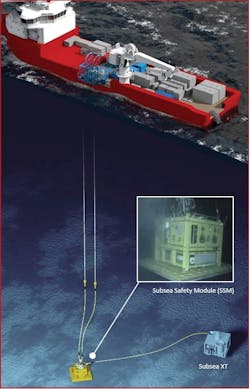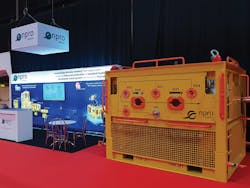Hydraulic intervention system helps maximize recovery from subsea wells
Ryan Sangster, Ian Donald, Chris McLaren, Enpro Subsea
The need for subsea well intervention services is expected to accelerate in the coming years as demand for energy continues to grow and operators look to maximize asset value. According to research, the global well intervention market was valued at nearly $6 billion in 2017 and is expected to increase by 6% compound annual growth rate by 2026.1
In the past, well intervention projects typically competed unfavorably with drilling projects for access to capex budgets, when operators were keen to expand their proven reserve portfolio. In today’s climate however, capital efficiency is the driver as operators seek to maximize ultimate recovery from their existing subsea assets. In particular, the adoption of hydraulic intervention strategies, where various liquid or gas treatments are pumped directly into the wellbore, are increasing.
Compared to mechanical well intervention, where coiled tube or slickline tools are traditionally deployed from a drilling unit or well services vessel and physically enter the wellbore through the tree cap, the range of hydraulic or liquid solutions is more focused. That said, the associated lower risks and lower costs make these strategies highly capital efficient. As subsea well intervention activity looks set to surge, operators have targeted safer, more sustainable and cost-effective solutions which do not require the use of a conventional workover rig.
Enpro Subsea has extended its existing range of flow intervention services (FIS) technologies, to enable fully tailored, low-cost hydraulic intervention solutions without the need for rig assistance. The modular solution can be deployed from a ROV support vessel or construction support vessel. By eliminating the need for a rig or a second support vessel, the operator can save up to 70% of traditional vessel and support costs, potentially saving $12 million on a 30-day multi-well intervention campaign.Field proven, rigless, hydraulic intervention
The team behind Enpro Subsea has been involved in subsea hydraulic intervention since the first vessel-based systems were deployed in the North Sea and Angola in the early 2000s. In the intervening years, the same team developed numerous subsea technologies including a low-pressure fluid intervention system designed for the decommissioning of gravity base structures in the North Sea.
In 2017, the company completed a 10ksi rated version of FIS which is suitable for single vessel configuration in a range of water depths up to 3,000 m (9,842 ft) and based on the emerging API17G intervention standard.
The system consists of:
• Topsides controls and umbilical; to manage chemical delivery operations
• Lower section dynamic ‘downline’; to deliver chemicals and minimize stresses
• Emergency quick disconnect; for improved environment safety
• Subsea safety module (SSM); to isolate and control fluids on the seabed
• Subsea interface; which works with multiple tree connections, including but not limited to the company’s patented FAM technology.
The FIS system is configured to be used with an upper ‘downline of opportunity,’ which delivers fluid from the vessel to the lower dynamic downline, be it single or dual line coiled tube or composite. The system is designed to deliver up to 30 b/min subject to downline specification. To meet client schedules, the compact modular design allows it to be safely air-freighted to the site.Over the past 18 months, it has been used in several multi-well campaigns in West Africa at water depths up to 1,800 m (5,905 ft) for multiple hydraulic intervention applications ranging from scale squeeze to acid stimulation operations. It has been proven to improve production by up to 65%, by stimulating the reservoir and increasing the ultimate recovery from these existing subsea wells.
Higher pressure
Following success of the 10ksi FIS system in West Africa, the company launched its 15ksi, 3,000 m version at Subsea Expo in Aberdeen in 2019. The development of the new higher capability hardware was supported by Scottish Enterprise. It is due to complete subsea trials later this year and encompasses design improvements from lessons learned from offshore operations of the 10ksi system. These improvements enable faster deployment and include enhanced safety features.
In addition to hydraulic intervention of the wells, the new system is configurable for other subsea chemical injection treatments, including hydrate remediate and flow assurance management.
Complimentary benefits
As a modular system, the SSM can be used with any subsea flow access point to gain access to well or pipeline flow, including the company’s proprietary flow access module (FAM) technology. In addition to facilitating hydraulic intervention, the FAM open architecture has been selected by operators as an enabling technology for subsea production systems standardization, leading to early first oil and future-proof field development strategies. Installing FAM hubs enables operators to retrofit any technology to its subsea architecture or react to any production challenges in future field life.FAM creates an enhanced production ‘USB port’ within the jumper envelope, which enables the use of standard subsea Xmas trees and manifolds, with the FAM providing life of field flexibility within the system design. Therefore, FAM delivers ‘smart standardization,’ enabling a range of production enhancing technologies for metering, flow measurement, flow assurance, and digital data access to be installed at any stage throughout the life of field.
The combination of the FIS and FAM range of products throughout the life of field delivers maximum recovery from existing and new subsea wells while minimizing risk and cost.
Where to next
The latest FIS system has been designed primarily for high-pressure subsea wells, typically found in deepwater assets in the Gulf of Mexico and West Africa. The system is available as a rental solution, supplied either as a full turnkey option, including vessel, chemical and well services or as a standalone flow intervention system to be integrated into a combined solution with the operator. The system is expected to be available for deployment in the Gulf of Mexico in 4Q 2019.
These types of flexible, lower-capital projects will increase as subsea developments continue in mature deepwater locations. Operators and supply chain companies are working together with the same drive, to push the limits of what is possible with current technology while creating new solutions for the future. •
Reference
1.) https://www.transparencymarketresearch.com/pressrelease/well-intervention-market.htm



